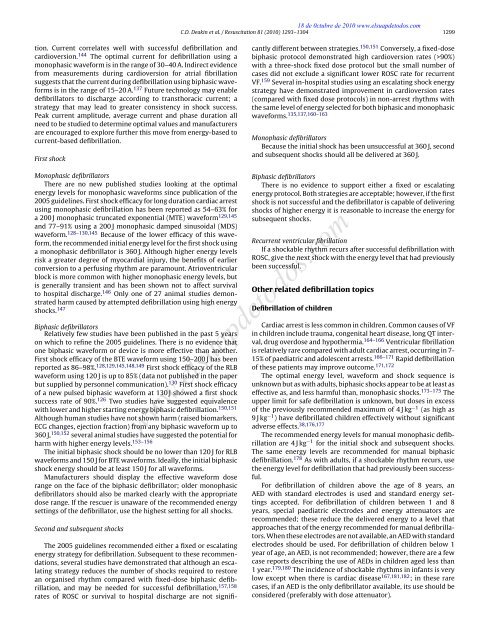European Resuscitation Council Guidelines for Resuscitation ... - CPR
European Resuscitation Council Guidelines for Resuscitation ... - CPR
European Resuscitation Council Guidelines for Resuscitation ... - CPR
You also want an ePaper? Increase the reach of your titles
YUMPU automatically turns print PDFs into web optimized ePapers that Google loves.
18 de 0ctubre de 2010 www.elsuapdetodos.comC.D. Deakin et al. / <strong>Resuscitation</strong> 81 (2010) 1293–1304 1299tion. Current correlates well with successful defibrillation andcardioversion. 144 The optimal current <strong>for</strong> defibrillation using amonophasic wave<strong>for</strong>m is in the range of 30–40 A. Indirect evidencefrom measurements during cardioversion <strong>for</strong> atrial fibrillationsuggests that the current during defibrillation using biphasic wave<strong>for</strong>msis in the range of 15–20 A. 137 Future technology may enabledefibrillators to discharge according to transthoracic current; astrategy that may lead to greater consistency in shock success.Peak current amplitude, average current and phase duration allneed to be studied to determine optimal values and manufacturersare encouraged to explore further this move from energy-based tocurrent-based defibrillation.First shockThe 2005 guidelines recommended either a fixed or escalatingenergy strategy <strong>for</strong> defibrillation. Subsequent to these recommendations,several studies have demonstrated that although an escalatingstrategy reduces the number of shocks required to restorean organised rhythm compared with fixed-dose biphasic defibrillation,and may be needed <strong>for</strong> successful defibrillation, 157,158rates of ROSC or survival to hospital discharge are not significantlydifferent between strategies. 150,151 Conversely, a fixed-dosebiphasic protocol demonstrated high cardioversion rates (>90%)with a three-shock fixed dose protocol but the small number ofcases did not exclude a significant lower ROSC rate <strong>for</strong> recurrentVF. 159 Several in-hospital studies using an escalating shock energystrategy have demonstrated improvement in cardioversion rates(compared with fixed dose protocols) in non-arrest rhythms withthe same level of energy selected <strong>for</strong> both biphasic and monophasicwave<strong>for</strong>ms. 135,137,160–163Monophasic defibrillatorsBecause the initial shock has been unsuccessful at 360 J, secondand subsequent shocks should all be delivered at 360 J.Monophasic defibrillatorsThere are no new published studies looking at the optimalenergy levels <strong>for</strong> monophasic wave<strong>for</strong>ms since publication of the2005 guidelines. First shock efficacy <strong>for</strong> long duration cardiac arrestusing monophasic defibrillation has been reported as 54–63% <strong>for</strong>a 200 J monophasic truncated exponential (MTE) wave<strong>for</strong>m 129,145and 77–91% using a 200 J monophasic damped sinusoidal (MDS)wave<strong>for</strong>m. 128–130,145 Because of the lower efficacy of this wave<strong>for</strong>m,the recommended initial energy level <strong>for</strong> the first shock usinga monophasic defibrillator is 360 J. Although higher energy levelsrisk a greater degree of myocardial injury, the benefits of earlierconversion to a perfusing rhythm are paramount. Atrioventricularblock is more common with higher monophasic energy levels, butis generally transient and has been shown not to affect survivalto hospital discharge. 146 Only one of 27 animal studies demonstratedharm caused by attempted defibrillation using high energyshocks. 147Biphasic defibrillatorsRelatively few studies have been published in the past 5 yearson which to refine the 2005 guidelines. There is no evidence thatone biphasic wave<strong>for</strong>m or device is more effective than another.First shock efficacy of the BTE wave<strong>for</strong>m using 150–200 J has beenreported as 86–98%. 128,129,145,148,149 First shock efficacy of the RLBwave<strong>for</strong>m using 120 J is up to 85% (data not published in the paperbut supplied by personnel communication). 130 First shock efficacyof a new pulsed biphasic wave<strong>for</strong>m at 130 J showed a first shocksuccess rate of 90%. 126 Two studies have suggested equivalencewith lower and higher starting energy biphasic defibrillation. 150,151Although human studies have not shown harm (raised biomarkers,ECG changes, ejection fraction) from any biphasic wave<strong>for</strong>m up to360 J, 150,152 several animal studies have suggested the potential <strong>for</strong>harm with higher energy levels. 153–156The initial biphasic shock should be no lower than 120 J <strong>for</strong> RLBwave<strong>for</strong>ms and 150 J <strong>for</strong> BTE wave<strong>for</strong>ms. Ideally, the initial biphasicshock energy should be at least 150 J <strong>for</strong> all wave<strong>for</strong>ms.Manufacturers should display the effective wave<strong>for</strong>m doserange on the face of the biphasic defibrillator; older monophasicdefibrillators should also be marked clearly with the appropriatedose range. If the rescuer is unaware of the recommended energysettings of the defibrillator, use the highest setting <strong>for</strong> all shocks.Second and subsequent shocksBiphasic defibrillatorsThere is no evidence to support either a fixed or escalatingenergy protocol. Both strategies are acceptable; however, if the firstshock is not successful and the defibrillator is capable of deliveringshocks of higher energy it is reasonable to increase the energy <strong>for</strong>subsequent shocks.Recurrent ventricular fibrillationIf a shockable rhythm recurs after successful defibrillation withROSC, give the next shock with the energy level that had previouslybeen successful.Other related defibrillation topicsDefibrillation of childrenCardiac arrest is less common in children. Common causes of VFin children include trauma, congenital heart disease, long QT interval,drug overdose and hypothermia. 164–166 Ventricular fibrillationis relatively rare compared with adult cardiac arrest, occurring in 7-15% of paediatric and adolescent arrests. 166–171 Rapid defibrillationof these patients may improve outcome. 171,172The optimal energy level, wave<strong>for</strong>m and shock sequence isunknown but as with adults, biphasic shocks appear to be at least aseffective as, and less harmful than, monophasic shocks. 173–175 Theupper limit <strong>for</strong> safe defibrillation is unknown, but doses in excessof the previously recommended maximum of 4 J kg −1 (as high as9Jkg −1 ) have defibrillated children effectively without significantadverse effects. 38,176,177The recommended energy levels <strong>for</strong> manual monophasic defibrillationare 4 J kg −1 <strong>for</strong> the initial shock and subsequent shocks.The same energy levels are recommended <strong>for</strong> manual biphasicdefibrillation. 178 As with adults, if a shockable rhythm recurs, usethe energy level <strong>for</strong> defibrillation that had previously been successful.For defibrillation of children above the age of 8 years, anAED with standard electrodes is used and standard energy settingsaccepted. For defibrillation of children between 1 and 8years, special paediatric electrodes and energy attenuators arerecommended; these reduce the delivered energy to a level thatapproaches that of the energy recommended <strong>for</strong> manual defibrillators.When these electrodes are not available, an AED with standardelectrodes should be used. For defibrillation of children below 1year of age, an AED, is not recommended; however, there are a fewcase reports describing the use of AEDs in children aged less than1 year. 179,180 The incidence of shockable rhythms in infants is verylow except when there is cardiac disease 167,181,182 ; in these rarecases, if an AED is the only defibrillator available, its use should beconsidered (preferably with dose attenuator).www.elsuapdetodos.com
















